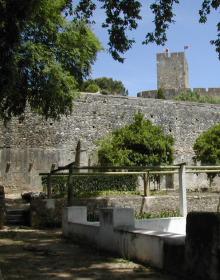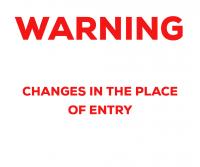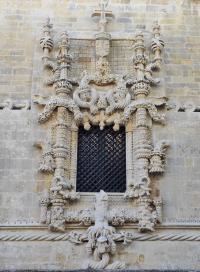- HOME
- MONUMENT
- Convent of Christ
- History
- Architecture
- Personalities
- King Afonso Henriques
- D. Gualdim Pais
- King Dinis
- King John I
- D. Lopo Dias de Sousa
- King Duarte
- Prince D. Henrique (Henry
- King John II (1455 - 1495
- King Manuel I (1469 - 152
- Diogo de Arruda
- João de Castilho
- Jorge Afonso
- Olivier de Gand
- King John III (1502 - 155
- Diogo de Torralva
- Friar Anthony of Lisbon
- Baltazar de Faria
- Filipe Terzi
- Philippine Dinasty
- King Philip II of Spain
- King John IV
- Domingos Serrão
- Queen Mary II
- Prince Fernando
- Costa Cabral
- Artisans and Artists
- Intangible Heritage
- Related Heritage
- Glossary
- VISIT OUR MONUMENT
- HERITAGE LEARNING
- TOMAR
- MONASTERIES ROUTE

The Knights Templar
Hugo of Payens, of Burgundy, was its founding master and, alongside the other knights, assumes a monastic vow of poverty, chastity and obedience. By 1128, the expanding brotherhood was recognized by the Troyes council as a monastic-military order, named Militia of the Poor Knights of Christ. The knights abandon the church of Saint Sepulchre - which had been ceded to them by Saint Augustine´s Regal Canons - in order to occupy the palace and other constructions located in the Herod terrace in the ancient temple in Jerusalem that were given to them by King Baldwin II. The Dome of the Rock (mosque), built by order of Caliph Omar in 642, was one of the constructions given to the knights where they set up their conventual church.
With time and linked to the Crusade-culture, the image of the mosque was transformed into an imaginary Salomon´s Temple and the knights began to be known as Knights of the Salomon Temple or simply as Templar. With the passing of time their mission also shifted - initially as defenders of pilgrims they now were defenders of the Christian states of the Holy Land. The Order was kept thanks to the numerous gifts that arrived from across Europe, methodically grouped and administered in Commendations.
Its mission lasted roughly 200 years - during this period Palestine was under domain by the crusaders and the Knights Templar´s power grew thanks to their military discipline and logistics organization. The fall of Jerusalem in 1291 marks the beginning of the tragic history of the Knights Templar. Prosecuted by Philip IV of France in a process initiated on October 13th of 1307, it culminates with the extinction of the Order as decreed by Pope Clement V on March 22nd of 1312 and the burning to death of the last Knights Templar master - Jacques de Molay - on October 1314.
The extinction process had, however, quite a different outcome in Portugal - King Dinis seeks to keep the Knights Templar and their assets under a new cavalry order circumscribed to his Kingdom: The Order of Christ.
SERVICES - ACTIVITIES



